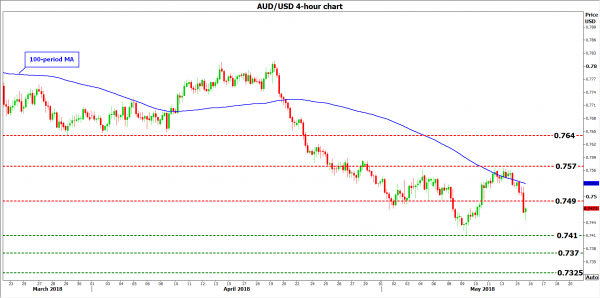In Australia this week, the main events will be the release of wage growth and employment data on Wednesday and Thursday respectively, both at 0130 GMT. Forecasts point to another set of decent figures, which may support the Aussie a little, but are unlikely to change the RBA’s neutral stance on policy.
The Reserve Bank of Australia (RBA) held its policy unchanged for the 19th consecutive meeting in early May, marking a new record for keeping interest rates stable. The Bank has long been faced with a tough dilemma: the economy is performing relatively well overall, but wages have not risen enough, keeping the nation’s heavily-indebted households relatively cautious of spending too much. Hence, policymakers have been keeping rates low, waiting for wages to accelerate and ease the debt burden on households, which would allow consumers to spend more in the future and boost economic growth.
That is not likely to be evident in this week’s data releases though, according to economic forecasts. The nation’s wage price index for Q1 is projected to have risen by 2.1% in yearly terms, the same rate as in the previous quarter. Meanwhile, the unemployment rate is anticipated to have held steady at 5.5% in April, while the net change in employment is expected to have risen by 20k, notably more than the lackluster 4.9k recorded in March. While the wage prints are arguably more significant for how the RBA may act, the employment figures have been generating a bigger reaction in the Aussie recently, and it will be interesting to see whether this pattern continues.
Should these prints come in stronger than expected, stoking expectations for a more hawkish tone by the RBA, then the aussie could recover some of its latest losses. Looking at aussie/dollar, advances in the pair could encounter immediate resistance at 0.7490, the inside swing low of May 4. An upside break of that line could open the way for 0.7570, the peak of May 11 and 14. Further up, the 0.7640 zone would come in focus, marked by the March 29 lows.
On the other hand, a disappointment in these data may diminish any surviving hopes for the RBA to appear more optimistic anytime soon and thereby, bring the aussie under renewed selling interest. Declines in aussie/dollar could stall initially near 0.7410, a level that halted the decline on May 9. If the bears overcome that barrier, that would mark a lower low in the pair, potentially opening the way for 0.7370, a level last seen in June 2017. Even lower, the 0.7325 area may come in play, defined by the trough of May 2017.












